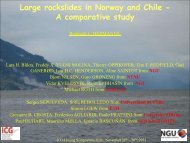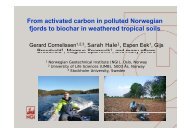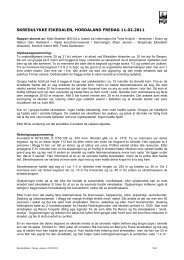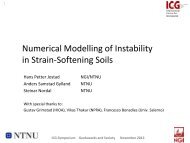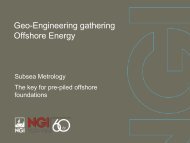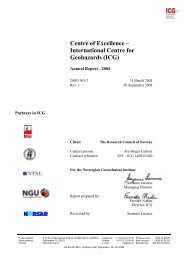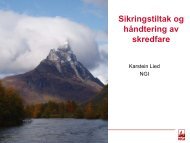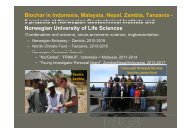International Centre for Geohazards (ICG)
International Centre for Geohazards (ICG)
International Centre for Geohazards (ICG)
You also want an ePaper? Increase the reach of your titles
YUMPU automatically turns print PDFs into web optimized ePapers that Google loves.
Partners in <strong>ICG</strong><br />
<strong>Centre</strong> of Excellence –<br />
<strong>International</strong> <strong>Centre</strong> <strong>for</strong><br />
<strong>Geohazards</strong> (<strong>ICG</strong>)<br />
Annual Report - 2009<br />
20031103-7 31 March 2010<br />
Client: The Research Council of Norway<br />
Contact person: Are Birger Carlson<br />
Contract reference: SFF – <strong>ICG</strong> 146035/420<br />
For the Norwegian Geotechnical Institute<br />
Report prepared by:<br />
Postal address: P.O. Box 3930 Ullevaal Stadion, N-0806 OSLO, NORWAY Telephone: (+47) 22 02 30 00 Postal account: 0814 51 60643<br />
Street address: Sognsveien 72, OSLO Telefax: (+47) 22 23 04 48 Bank account: 5096 05 01281<br />
Internet: http://www.ngi.no e -mail: ngi@ngi.no Business No. 958 254 318 MVA<br />
BS EN ISO 9001, Certified by BSI, Registration No. FS 32989<br />
Suzanne Lacasse<br />
Managing Director<br />
Farrokh Nadim<br />
Director, <strong>ICG</strong><br />
Reviewed by: Suzanne Lacasse<br />
Bjørn Kalsnes
<strong>International</strong> <strong>Centre</strong> <strong>for</strong> <strong>Geohazards</strong> Report No.: 20031103-7<br />
Date: 2010-03-31<br />
Rev.: -<br />
Annual Report - 2009 Rev. date:<br />
Page: 2<br />
Summary<br />
The "<strong>International</strong> <strong>Centre</strong> <strong>for</strong> <strong>Geohazards</strong>" (<strong>ICG</strong>) is one the 13 <strong>Centre</strong>s of Excellence<br />
(Senter <strong>for</strong> Fremragende Forskning, SFF) established by The Research Council of<br />
Norway (RCN) in 2003. The Norwegian Geotechnical Institute (NGI) is the host<br />
organisation <strong>for</strong> <strong>ICG</strong>. Partners in the centre are the University of Oslo (UiO), the<br />
Norwegian University of Science and Technology (NTNU), NORSAR, and the<br />
Geological Survey of Norway (NGU).<br />
Results and activities in 2009<br />
The research plan was followed and the goals set <strong>for</strong> the year were achieved. With<br />
respect to four major goals of <strong>ICG</strong>, a) in-kind contribution from the partners, b)<br />
complementary projects from the industry, c) number of PhD candidates, and d)<br />
international networking, the results have exceeded by far the goals and expectations.<br />
The focus of <strong>ICG</strong>’s research in 2009 was on:<br />
- Assessment of the risks associated with geohazards to individuals and society.<br />
- Development and improvement of methods <strong>for</strong> modelling the mechanical processes<br />
underlying the physical phenomena of different geohazards and <strong>for</strong> evaluating<br />
the consequences of geohazards.<br />
- <strong>Geohazards</strong> prevention and risk mitigation strategies.<br />
- Collaborative research ef<strong>for</strong>ts with European partners in European Commission’s<br />
7 th Framework Programme (FP7).<br />
- Graduate university programmes on geohazards at UiO and NTNU<br />
Joint workshops, seminars, and project meetings contributed to further enhance the<br />
good collaboration among the five partners.<br />
The large-scale integrating project SafeLand (Living with landslide risk in Europe:<br />
Assessment, effects of global change and risk management strategies) within FP7<br />
started in May 2009. <strong>ICG</strong> is the coordinator of this project, which has 27 European<br />
partners and several international partners from USA and Asia.<br />
There is considerable interest and enthusiasm about the activities of <strong>ICG</strong>, both in<br />
Norway and abroad.<br />
Challenges <strong>for</strong> 2010<br />
The overall research plan remains essentially unchanged. The main challenges <strong>for</strong>eseen<br />
<strong>for</strong> 2010 include:<br />
Finding complementary funding sources to maintain the high activity level at <strong>ICG</strong><br />
through the end of 2012.<br />
Research on complex issues such as vulnerability and risk assessment, tsunami runup<br />
estimation, disintegration of material during sliding, rainfall-induced landslides,<br />
earthquake response, etc.<br />
Identification of the niches where the combined expertise of <strong>ICG</strong> partners could be<br />
put into practical use on the international arena.<br />
Networking with centres of expertise who work on the societal aspects of the risk<br />
associated with geohazards.<br />
Further work on identifying the most appropriate strategies <strong>for</strong> geohazards<br />
prevention and risk mitigation.<br />
f:\p\2003\11\20031103\icg annual reports\2009-annual-report\icg-annual_report7_2009.doc FNa/tha
<strong>International</strong> <strong>Centre</strong> <strong>for</strong> <strong>Geohazards</strong> Report No.: 20031103-7<br />
Date: 2010-03-31<br />
Rev.: -<br />
Annual Report - 2009 Rev. date:<br />
Page: 3<br />
Implementing the achievements made at <strong>ICG</strong> in practical use within the partner<br />
organisations.<br />
Attracting PhD candidates, post-docs and guest researchers to Norway.<br />
Active participation in the research programmes on natural hazards and risk<br />
management in the 7 th Frame Programme.<br />
Running and planning new international conferences, seminars and workshops.<br />
Increased publication in highly respected scientific journals.<br />
f:\p\2003\11\20031103\icg annual reports\2009-annual-report\icg-annual_report7_2009.doc FNa/tha
<strong>International</strong> <strong>Centre</strong> <strong>for</strong> <strong>Geohazards</strong> Report No.: 20031103-7<br />
Date: 2010-03-31<br />
Rev.: -<br />
Annual Report - 2009 Rev. date:<br />
Page: 4<br />
Contents<br />
1 BACKGROUND ......................................................................................................................... 5<br />
2 ORGANISATION OF <strong>ICG</strong> ......................................................................................................... 5<br />
3 ACTIVITIES OF <strong>ICG</strong>’S STEERING COMMITTEE ................................................................ 9<br />
4 TECHNICAL ACTIVITIES OF <strong>ICG</strong> IN 2009 ........................................................................... 9<br />
4.1 Core research activities ..................................................................................................... 9<br />
4.2 The FP7 Project SafeLand .............................................................................................. 10<br />
4.3 Earthquake triggered landslides in southern Chile / Patagonia ....................................... 13<br />
5 NATIONAL AND INTERNATIONAL COOPERATION, AND OTHER <strong>ICG</strong><br />
ACTIVITIES IN 2009 ............................................................................................................... 15<br />
5.1 <strong>ICG</strong> Publications in 2009 ................................................................................................ 15<br />
5.2 Workshops and international contacts ............................................................................ 15<br />
5.3 Web site........................................................................................................................... 16<br />
6 DOCTORAL CANDIDATES AND GUEST RESEARCHERS IN 2009 ................................ 17<br />
7 ACCOUNTING 2009................................................................................................................ 18<br />
7.1 Cash funding (kNOK) ..................................................................................................... 18<br />
7.2 In kind (kNOK) ............................................................................................................... 19<br />
7.3 Total (kNOK) .................................................................................................................. 19<br />
8 PLANNED ACTIVITIES AND BUDGET FOR 2010 ............................................................. 19<br />
8.1 Research Projects and Education .................................................................................... 19<br />
8.2 <strong>International</strong> networking ................................................................................................. 19<br />
8.3 EU projects in the 7 th Framework Programme ................................................................ 20<br />
8.4 IPCC work....................................................................................................................... 20<br />
8.5 Organising conferences and workshops in 2010 ............................................................. 20<br />
8.6 <strong>ICG</strong> budget <strong>for</strong> 2010 ....................................................................................................... 21<br />
Appendix A – <strong>ICG</strong> Publications in 2009<br />
Review and reference document<br />
f:\p\2003\11\20031103\icg annual reports\2009-annual-report\icg-annual_report7_2009.doc FNa/tha
<strong>International</strong> <strong>Centre</strong> <strong>for</strong> <strong>Geohazards</strong> Report No.: 20031103-7<br />
Date: 2010-03-31<br />
Rev.: -<br />
Annual Report - 2009 Rev. date:<br />
Page: 5<br />
1 BACKGROUND<br />
The "<strong>International</strong> <strong>Centre</strong> <strong>for</strong> <strong>Geohazards</strong>" (<strong>ICG</strong>) is a <strong>Centre</strong> of Excellence<br />
(Senter <strong>for</strong> Fremragende Forskning, SFF) established by the Research Council<br />
of Norway in 2003. The Norwegian <strong>Centre</strong>s of Excellence scheme is designed<br />
to stimulate Norwegian research groups to set up centres devoted to long-term<br />
basic research. The intention is to raise the quality of Norwegian research and<br />
bring more researchers and research groups up to a high international standard.<br />
<strong>ICG</strong> is a consortium of five partners. Norwegian Geotechnical Institute (NGI)<br />
is the host organisation <strong>for</strong> <strong>ICG</strong>. Other partners in the centre are University of<br />
Oslo (UiO), Norwegian University of Science and Technology (NTNU),<br />
NORSAR, and Geological Survey of Norway (NGU). The consortium may be<br />
expanded with "associated partners" subject to agreement by all five main partners.<br />
<strong>ICG</strong>’s objective is to be an international centre of expertise on basic and<br />
applied research on geo-related natural hazards (geohazards), such as landslides,<br />
earthquakes and tsunamis. However, the frameworks and methodologies<br />
developed <strong>for</strong> the assessment of hazard, vulnerability and risk may also be<br />
applied <strong>for</strong> other types of threats. The main aim of <strong>ICG</strong> is to develop<br />
knowledge that can help save lives and reduce damage to infrastructure and the<br />
environment. Another aim is to train graduate students and highly-qualified<br />
researchers from Norway and abroad.<br />
<strong>ICG</strong> prioritised international networking, and its status of “<strong>Centre</strong> of<br />
Excellence” contributed to opening many doors. In 2008, <strong>ICG</strong> was awarded the<br />
status of “World <strong>Centre</strong> of Excellence” in Japan, by the <strong>International</strong><br />
Consortium <strong>for</strong> Landslides.<br />
2 ORGANISATION OF <strong>ICG</strong><br />
<strong>ICG</strong> has its own Board of Directors (Steering Committee). Each of the <strong>ICG</strong><br />
partners, NGI, NTNU, UiO, NORSAR and NGU, has a representative on the<br />
Steering Committee. In addition, the Steering Committee has at least one<br />
external representative from Norway and one international representative. The<br />
Research Council of Norway may also appoint a member to the Steering Committee.<br />
<strong>ICG</strong> has associated partners, e.g. University of Tromsø, but they do not<br />
have a representative on the Steering Committee. As the host organisation,<br />
NGI appointed the director of <strong>ICG</strong>, and NGI’s representative is the chairman of<br />
the Steering Committee.<br />
The activities of the <strong>ICG</strong> are grouped into three categories:<br />
1. Research projects<br />
2. Training and education<br />
3. <strong>International</strong> networking and dissemination of in<strong>for</strong>mation<br />
f:\p\2003\11\20031103\icg annual reports\2009-annual-report\icg-annual_report7_2009.doc FNa/tha
<strong>International</strong> <strong>Centre</strong> <strong>for</strong> <strong>Geohazards</strong> Report No.: 20031103-7<br />
Date: 2010-03-31<br />
Rev.: -<br />
Annual Report - 2009 Rev. date:<br />
Page: 6<br />
The organisation chart and the project chart of <strong>ICG</strong> are shown on the following<br />
pages. The <strong>ICG</strong> projects and other <strong>ICG</strong> activities are elaborated further later in<br />
the report.<br />
f:\p\2003\11\20031103\icg annual reports\2009-annual-report\icg-annual_report7_2009.doc FNa/tha
<strong>International</strong> <strong>Centre</strong> <strong>for</strong> <strong>Geohazards</strong> Report No.: 20031103-7<br />
Date: 2010-03-31<br />
Rev.: -<br />
Annual Report - 2009 Rev. date:<br />
Page: 7<br />
Board of Directors<br />
Prof. Kaare Høeg (UiO/NGI), Chairman Prof. Herbert Einstein (MIT)<br />
Dr Øystein Nordgulen (NGU) Prof. Steinar Nordal (NTNU)<br />
Prof. Andreas Kääb (UiO) Hallvard Berg (NVE)<br />
Anders Dahle (NORSAR) Tor-Inge Tjelta (Statoil)<br />
<strong>ICG</strong> Project 1<br />
Project Manager<br />
Researchers<br />
Students<br />
Technical Adviser<br />
Prof. Kaare Høeg<br />
<strong>ICG</strong> Project 2<br />
Project Manager<br />
Researchers<br />
Students<br />
Organisation chart of <strong>ICG</strong> as of 31 December 2009<br />
<strong>ICG</strong> Project 3<br />
Project Manager<br />
Researchers<br />
Students<br />
NGI<br />
Suzanne Lacasse<br />
Managing Director<br />
Dr. Farrokh Nadim, Director<br />
Bjørn Kalsnes, Deputy Director<br />
Tini van der Harst, Administrative Assistant<br />
<strong>ICG</strong> Research Projects and Themes<br />
<strong>ICG</strong> Project 4<br />
Project Manager<br />
Researchers<br />
Students<br />
<strong>ICG</strong> Project 5<br />
Project Manager<br />
Researchers<br />
Students<br />
<strong>International</strong> Scientific Advisors<br />
Prof. Gholamreza Mesri (U.of Illinois)<br />
Prof. Herbert H. Einstein (MIT)<br />
Prof. Steven Kramer (U. of Washington)<br />
Prof. Kok-Kwang Phoon (Nat. U. of Singapore)<br />
Theme A - Theme Coordinator Theme B - Theme Coordinator Theme C - Theme Coordinator<br />
<strong>ICG</strong> Project N<br />
Project Manager<br />
f:\p\2003\11\20031103\icg annual reports\2009-annual-report\icg-annual_report7_2009.doc FNa/tha<br />
Researchers<br />
Students
<strong>International</strong> <strong>Centre</strong> <strong>for</strong> <strong>Geohazards</strong> Report No.: 20031103-7<br />
Date: 2010-03-31<br />
Rev.: -<br />
Annual Report - 2009 Rev. date:<br />
Page: 8<br />
<strong>ICG</strong> Project Project Managers Post-docs & Guest Researchers<br />
Risk and vulnerability analysis <strong>for</strong> geohazards Dr Suzanne Lacasse (NGI) Zhihong Li, Mona Khaleghy-Rad<br />
Earthquakes – hazard, risk and loss estimation Prof. Hilmar Bungum (NORSAR) Dr Daniela Kühn, Filippo Marchi<br />
Stability of rock slopes Dr Reginald Hermanns (NGU)<br />
Geomechanical modelling Prof. Steinar Nordal (NTNU) Ariane Locat<br />
Offshore geohazards Dr Maarten Vanneste (NGI) Cody Jones, Jean-Sébastien L'Heureux, Guillaume Sauvin<br />
Slope instability assessment and hazard zonation Dr Kalle Kronholm (NGI) Mads-Peter Dahl, Maria Mammoliti<br />
Tsunami modelling and prediction Dr Carl Harbitz (NGI) Dr Sara Bazin, Dr Gunilla Kaiser<br />
Monitoring, remote sensing and early warning systems Prof. Andreas Kääb (UiO) Dr Regula Frauenfelder, Florian Köllner, Alexandre Tourette<br />
PhD-candidates at UiO & NTNU:<br />
Maj Gøril Glåmen (NTNU)<br />
Guro Grøneng (NTNU)<br />
Harald Iwe (UiO)<br />
Trond Nordvik (NTNU)<br />
Bård Romsdal (UiO)<br />
Samson Degago (NTNU)<br />
Anders Gylland (NTNU)<br />
Annika Bihs (NTNU)<br />
Magnus Sparrevik (NTNU)<br />
Håkon Heyerdahl (UiO)<br />
Misganu Debella Gilo (UiO)<br />
Hom Nath Gharti (UiO)<br />
Rolv Bredesen (UiO)<br />
David Unteregger (NTNU)<br />
Martina Böhme (NTNU)<br />
Technical Adviser<br />
Prof. Kaare Høeg<br />
Project chart of <strong>ICG</strong> as of 31 December 2009<br />
Dr. Farrokh Nadim, Director<br />
Bjørn Kalsnes, Deputy Director<br />
Tini van der Harst, Administrative Assistent<br />
Themes covering several projects Theme Coordinator<br />
Geophysics <strong>for</strong> geohazards<br />
Prevention and mitigation of geohazards<br />
<strong>ICG</strong>-affiliated PhD-candidates in other<br />
universities than UiO and NTNU:<br />
Chang Shin Gue (Cambridge Univ., UK)<br />
Sook Ling Lee (Cambridge Univ., UK)<br />
Tom Rune Lauknes (Univ. of Tromsø)<br />
Dr Isabelle Lecomte (NORSAR)<br />
Dr Farrokh Nadim (NGI)<br />
PhDs awarded in 2009:<br />
Hedda Breien (UiO)<br />
José Cepeda (UiO)<br />
Gunnstein Sælevik (UiO)<br />
Gustav Grimstad (NTNU)<br />
Jean-Sébastien L'Heureux (NTNU)<br />
<strong>International</strong> Scientific Advisors<br />
Prof. Gholamreza Mesri (U.of Illinois)<br />
Prof. Herbert H. Einstein (MIT)<br />
Prof. Steven Kramer (U. of Washington)<br />
Prof. Kok-Kwang Phoon (Nat. U. of Singapore<br />
Professors from Norway active in <strong>ICG</strong>:<br />
Anders Elverhøi (UiO)<br />
Bernd Etzelmüller (UiO)<br />
Leiv-Jacob Gelius (UiO)<br />
Bjørn Gjevik (UiO)<br />
Lars Grande (NTNU)<br />
Svein Hamran (UiO)<br />
Kaare Høeg (UiO)<br />
Andreas Kääb (UiO)<br />
Hans Petter Langtangen (UiO)<br />
Terje Midtbø (NTNU)<br />
Farrokh Nadim (NTNU & UiO)<br />
Bjørn Nilsen (NTNU)<br />
Steinar Nordal (NTNU)<br />
Geir Kleivstul Pedersen (UiO)<br />
Hans Petter Jostad (NTNU)<br />
Thomas Benz (NTNU)<br />
f:\p\2003\11\20031103\icg annual reports\2009-annual-report\icg-annual_report7_2009.doc FNa/tha
<strong>International</strong> <strong>Centre</strong> <strong>for</strong> <strong>Geohazards</strong> Report No.: 20031103-7<br />
Date: 2010-03-31<br />
Rev.: -<br />
Annual Report - 2009 Rev. date:<br />
Page: 9<br />
3 ACTIVITIES OF <strong>ICG</strong>’S STEERING COMMITTEE<br />
The main responsibility of <strong>ICG</strong>’s Steering Committee is to set the priorities in<br />
the yearly research plans. The Steering Committee also acts as a technical<br />
advisor to the Director of <strong>ICG</strong>.<br />
The Steering Committee shall also discuss and deal with<br />
annual budget<br />
annual technical report(s)<br />
annual financial report<br />
The annual technical and financial report (this document) is prepared by the<br />
Director of the <strong>Centre</strong> and delivered to the Managing Director of NGI, who is<br />
responsible <strong>for</strong> reporting the activities of <strong>ICG</strong> to The Research Council of<br />
Norway.<br />
The <strong>ICG</strong> Steering Committee is composed of:<br />
Prof. Kaare Høeg (UiO/NGI), Chairman<br />
Dr Øystein Nordgulen (NGU)<br />
Prof. Andreas Kääb (UiO)<br />
Mr Anders Dahle (NORSAR)<br />
Prof. Steinar Nordal (NTNU)<br />
Mr Hallvard Berg (NVE)<br />
Mr Tor-Inge Tjelta (Statoil)<br />
Prof. Herbert Einstein (MIT, USA)<br />
The Steering Committee held 2 meetings in 2009:<br />
Meeting No. 1/09: 23 March 2009<br />
Meeting No. 2/09: 4 December 2009<br />
The following meetings in 2010 are planned:<br />
Meeting No. 1/10: 26 March 2010<br />
Meeting No. 2/10: 3 December 2010<br />
One of the main topics of discussion <strong>for</strong> the <strong>ICG</strong> Steering Committee in 2010<br />
is the evaluation of different models <strong>for</strong> <strong>ICG</strong>’s future after 2012.<br />
4 TECHNICAL ACTIVITIES OF <strong>ICG</strong> IN 2009<br />
4.1 Core research activities<br />
<strong>ICG</strong> divided its technical activities in 2009 into eight projects, and significant<br />
progress was done on each:<br />
f:\p\2003\11\20031103\icg annual reports\2009-annual-report\icg-annual_report7_2009.doc FNa/tha
<strong>International</strong> <strong>Centre</strong> <strong>for</strong> <strong>Geohazards</strong> Report No.: 20031103-7<br />
Date: 2010-03-31<br />
Rev.: -<br />
Annual Report - 2009 Rev. date:<br />
Page: 10<br />
Risk and vulnerability analysis <strong>for</strong> geohazards<br />
Earthquakes – hazard, risk and loss estimation<br />
Stability of rock slopes<br />
Geomechanical modelling<br />
Offshore geohazards<br />
Slope instability assessment and hazard zonation<br />
Tsunami modelling and prediction<br />
Monitoring, remote sensing and early warning systems<br />
In addition to these projects, two "themes" that involve several projects were<br />
given high priority, and a Theme Coordinator was designated <strong>for</strong> streamlining<br />
the lateral cooperation among the technical projects in each theme:<br />
Applications of geophysics to geohazards<br />
Prevention and mitigation of geohazards<br />
Detailed in<strong>for</strong>mation about the <strong>ICG</strong> technical projects and themes is available<br />
on the <strong>ICG</strong> web site www.geohazards.no.<br />
In 2009 the partners in the <strong>ICG</strong> were involved in several high profile national<br />
and international projects. Two of these projects are presented below.<br />
4.2 The FP7 Project SafeLand<br />
Statistics from The <strong>Centre</strong> <strong>for</strong> Research on the Epidemiology of Disasters<br />
(CRED) show that, on average, landslides are responsible <strong>for</strong> a small<br />
percentage of all fatalities from natural hazards worldwide. The socioeconomic<br />
impact of landslides is underestimated because landslides are usually<br />
not separated from other natural hazard triggers, such as extreme precipitation,<br />
earthquakes or floods. This underestimation contributes to reducing the<br />
awareness and concern of both authorities and general public about landslide<br />
risk. In the last century, according to the EM-DAT data base 16,000 people<br />
have lost their lives because of landslides and the material losses amounted to<br />
over USD 1700 mill. in Europe during the 20th century (see Fig. 4.1). The<br />
actual casualty figures shown below are likely to be greatly underestimated in<br />
the EM-DAT because events with less than 10 persons killed are not reported.<br />
Furthermore, the number of people affected by landslides is much larger than<br />
reported. For example in Italy, while about 500 people have been killed by<br />
landslides over the past 25 years, the total number of persons impacted is 50<br />
times that number.<br />
As a consequence of climate change and increase in exposure in many parts of<br />
the world, the risk associated with landslides is growing. In areas with high<br />
demographic density, protection works often cannot be built because of<br />
economic or environmental constraints, and is it not always possible to<br />
evacuate people because of societal reasons. One needs to <strong>for</strong>ecast the<br />
f:\p\2003\11\20031103\icg annual reports\2009-annual-report\icg-annual_report7_2009.doc FNa/tha
<strong>International</strong> <strong>Centre</strong> <strong>for</strong> <strong>Geohazards</strong> Report No.: 20031103-7<br />
Date: 2010-03-31<br />
Rev.: -<br />
Annual Report - 2009 Rev. date:<br />
Page: 11<br />
occurrence of landslide and the hazard and risk associated with them. Climate<br />
change, increased susceptibility of surface soil to instability, anthropogenic<br />
activities, growing urbanisation, uncontrolled land-use and increased<br />
vulnerability of population and infrastructure as a result, contribute to the<br />
growing landslide risk. According to the Thematic Strategy <strong>for</strong> Soil Protection<br />
(COM232/2006), landslides are one of the main eight threats to European soils.<br />
Water has a major role in triggering of landslides.<br />
Fig. 4.1 Number of fatalities (left) and cost of damage (right) caused by<br />
landslides 1903 to 2004. Source: EM-DAT – The OFDA/CRED<br />
<strong>International</strong> Disaster database.<br />
The project SafeLand (Living with landslide risk in Europe: Assessment, effects<br />
of global change, and risk management strategies) is a Large-scale integrating<br />
Collaborative research project funded by the Seventh Framework Programme<br />
<strong>for</strong> research and technological development (FP7) of the European<br />
Commission. Thematically the project belongs to Cooperation Theme 6<br />
Environment (including climate change), Sub-Activity 6.1.3 Natural Hazards.<br />
The project team, which comprises 27 organisations from 13 European<br />
countries, is coordinated by <strong>ICG</strong>.<br />
SafeLand will develop generic quantitative risk assessment and management<br />
tools and strategies <strong>for</strong> landslides at local, regional, European and societal<br />
scales and establish the baseline <strong>for</strong> the risk associated with landslides in<br />
Europe, to improve our ability to <strong>for</strong>ecast landslide hazard and detect hazard<br />
and risk zones. The scientific work packages in SafeLand are organised in five<br />
Areas:<br />
Area 1 focuses on improving the knowledge on triggering mechanisms,<br />
processes and thresholds, including climate-related and anthropogenic<br />
triggers (e.g. the quick-clay slide at Kattmarksvegen, Namsos, see Fig.<br />
4.1) and on run-out models in landslide hazard assessment;<br />
Area 2 harmonises quantitative risk assessment methodologies <strong>for</strong><br />
different spatial scales, looking into uncertainties, vulnerability,<br />
landslide susceptibility, landslide frequency, and identifying hotspots in<br />
Europe with higher landslide hazard and risk;<br />
Area 3 focuses on future climate change scenarios and changes in<br />
demography and infrastructure, resulting in the evolution of hazard and<br />
risk in Europe at selected hotspots;<br />
f:\p\2003\11\20031103\icg annual reports\2009-annual-report\icg-annual_report7_2009.doc FNa/tha
<strong>International</strong> <strong>Centre</strong> <strong>for</strong> <strong>Geohazards</strong> Report No.: 20031103-7<br />
Date: 2010-03-31<br />
Rev.: -<br />
Annual Report - 2009 Rev. date:<br />
Page: 12<br />
Area 4 addresses the technical and practical issues related to monitoring<br />
and early warning <strong>for</strong> landslides, and identifies the best technologies<br />
available both in the context of hazard assessment and in the context of<br />
design of early warning systems;<br />
Area 5 provides a toolbox of risk mitigation strategies and guidelines<br />
<strong>for</strong> choosing the most appropriate risk management strategy.<br />
Maintaining the database of case studies, dissemination of the project results,<br />
and project management and coordination are defined in Work Packages 6, 7<br />
and 8.<br />
Fig. 4.2 Quick-clay slide triggered by road construction activities at<br />
Kattmarksvegen, Namsos, Norway, on 13 March 2009.<br />
The growing hazard and risk, the need to protect people and property, the<br />
expected climate change and the reality <strong>for</strong> society in Europe to live with<br />
hazard and risk and the need to manage risk are the reasons <strong>for</strong> the project<br />
consortium to carry out the SafeLand Research. SafeLand has <strong>for</strong> objectives to:<br />
1. Provide policy-makers, public administrators, researchers, scientists,<br />
educators and other stakeholders with an improved harmonised<br />
framework and methodology <strong>for</strong> the assessment and quantification of<br />
landslide risk in Europe's regions;<br />
2. evaluate the changes in risk pattern caused by climate change, human<br />
activity and policy changes; and<br />
3. provide guidelines <strong>for</strong> choosing the most appropriate risk management<br />
strategies, including risk mitigation and prevention measures.<br />
SafeLand will develop and implement an integrated and comprehensive<br />
approach to help guide decision-making. The methodologies developed will be<br />
tested in selected hazard and risk "hotspots” in Europe, in turn improving<br />
f:\p\2003\11\20031103\icg annual reports\2009-annual-report\icg-annual_report7_2009.doc FNa/tha
<strong>International</strong> <strong>Centre</strong> <strong>for</strong> <strong>Geohazards</strong> Report No.: 20031103-7<br />
Date: 2010-03-31<br />
Rev.: -<br />
Annual Report - 2009 Rev. date:<br />
Page: 13<br />
knowledge, methodologies and integration strategies <strong>for</strong> the management of<br />
landslide risk. SafeLand stresses the necessity of integrating the technology<br />
and social aspects to ensure that the risk assessment and management strategies<br />
are realistic and representative of the <strong>for</strong>ces at play in an actual situation.<br />
Global changes, due to both climate and human activity, will provide insight in<br />
future risk patterns. The landslide risk assessment and management strategies<br />
developed in the SafeLand project will be implemented to <strong>for</strong>ecast future risk.<br />
When the research is completed, SafeLand will provide Member States with<br />
the means to contribute to the Soil Framework Directive, using well understood<br />
and commonly adopted risk assessment and management terminology and<br />
methodology and harmonised approaches and tools, and will have insight in the<br />
potential effects of global change (climatic and anthropogenic) scenarios.<br />
4.3 Earthquake triggered landslides in southern Chile / Patagonia<br />
On April 21 st , 2007, the Aysén Fjord Earthquake (Mw 6.2) in southern Chile<br />
triggered hundreds of landslides in the epicentral area along the fjord coast and<br />
surroundings (Fig. 4.3). The seismicity was associated with tectonic activity in<br />
the Liquiñe-Ofqui Fault Zone (LOFZ), a major structural feature of the region.<br />
The landslides included rock slides and avalanches, rock falls, shallow soil and<br />
soil-rock slides, and debris flows. Some of the major rock slides and rock<br />
avalanches caused large tsunamis that impacted the fjord coasts.<br />
Fig. 4.3 Distribution of landslides triggered by the April 21, 2007 Aysén<br />
earthquake (Sepulveda et al., in press).<br />
f:\p\2003\11\20031103\icg annual reports\2009-annual-report\icg-annual_report7_2009.doc FNa/tha
<strong>International</strong> <strong>Centre</strong> <strong>for</strong> <strong>Geohazards</strong> Report No.: 20031103-7<br />
Date: 2010-03-31<br />
Rev.: -<br />
Annual Report - 2009 Rev. date:<br />
Page: 14<br />
Fig. 4.4 Tectonic setting of the April 21, 2007 Aysén earthquake (red box<br />
corresponds to Fig. 4.3).<br />
Preliminary results suggest that at least two general families of NE and NW<br />
trending faults are present in the area. These fault systems have been active<br />
with changing geometries. The changes can be documented both in the mineral<br />
fabrics (fault de<strong>for</strong>mation deeper in the crust) and the orientation of fractures<br />
(near surface de<strong>for</strong>mation). The de<strong>for</strong>mation is not concentrated along a single<br />
fault line but spreads over a wider area. In coincidence with de<strong>for</strong>med deposits<br />
not older than the last glaciations, this indicates that fault de<strong>for</strong>mation is<br />
relatively young and ongoing today.<br />
The faults provide important break-away or sliding surfaces <strong>for</strong> the most<br />
voluminous rockslides. However, rock failures at all sites are controlled by<br />
multiple failure surfaces. While fault zones <strong>for</strong>m large failure surfaces with<br />
persistence of tens to hundreds of metres, minor structures <strong>for</strong>m more complex<br />
failure planes cutting through intact or damaged fault rock. Land- and seabased<br />
photogrammetric analyses of rockslide release surfaces allow one to<br />
estimate some properties of the displaced materials and rupture planes. The<br />
comparison of digital elevation models will permit computation of accurate and<br />
precise volume/epicentral distance relations of the rockslides. These data sets<br />
will be used <strong>for</strong> dynamic rock slope stability analyses. Preliminary results<br />
indicate that largest rockslide volumes broke away close to major fault<br />
structures. Areas not affected by faults have not experienced large volume<br />
break-offs but superficial soil slides.<br />
Entrainment of surface material into the rockslides can be substantial.<br />
Preliminary estimates of entrainment of soil and vegetation into the Punta Cola<br />
rock avalanche indicate that those materials comprised 15-20% of the entire<br />
rock avalanche volume. In addition, detailed topography using terrestrial laser<br />
scanning also allows understanding the sequence of sliding. Landslide deposits<br />
in <strong>for</strong>m lobes with high soil content overlying fresh bedrock landslide debris<br />
f:\p\2003\11\20031103\icg annual reports\2009-annual-report\icg-annual_report7_2009.doc FNa/tha
<strong>International</strong> <strong>Centre</strong> <strong>for</strong> <strong>Geohazards</strong> Report No.: 20031103-7<br />
Date: 2010-03-31<br />
Rev.: -<br />
Annual Report - 2009 Rev. date:<br />
Page: 15<br />
suggest secondary landslides were caused by scouring of valley walls by<br />
rockslides with high mobility (Fig. 4.5).<br />
Fig. 4.5 Soil rich landslide deposits in <strong>for</strong>m of a lobe (in the <strong>for</strong>eground of<br />
photo) in the run-out area of the Punta Cola rock avalanche indicate<br />
that scouring by the highly mobile rock avalanche along valley walls<br />
caused secondary landslides contributing significantly to the total<br />
landslide volume. The terrestrial laser scanner point cloud (right)<br />
with similar view as the photograph (left) reveals the morphology of<br />
the different deposits, including the soil rich lobe deposited onto the<br />
rock avalanche deposits.<br />
5 NATIONAL AND INTERNATIONAL COOPERATION, AND OTHER<br />
<strong>ICG</strong> ACTIVITIES IN 2009<br />
5.1 <strong>ICG</strong> Publications in 2009<br />
The <strong>ICG</strong> Publication List <strong>for</strong> 2009 is given in Appendix A.<br />
5.2 Workshops and international contacts<br />
<strong>ICG</strong> organised two workshops in 2009:<br />
Workshop on Seabed Sediment Pore Pressure: Genesis, Measurement<br />
and Implication <strong>for</strong> Design/Analysis, 24-25 March, Oslo.<br />
Workshop on Geomechanical Modelling, 31 August & 1 September,<br />
Trondheim.<br />
The first workshop was an <strong>International</strong> event co-sponsored by the National<br />
Science Foundation. About 50 participants from Europe, North America, Asia<br />
and Australia participated in the workshop. In addition to representatives from<br />
the academia and industry, 12 PhD-candidates were among the participants.<br />
The second workshop was organised by NTNU at Teveltunet near Trondheim.<br />
The workshop gathered more than 20 PhD candidates and professionals <strong>for</strong> two<br />
f:\p\2003\11\20031103\icg annual reports\2009-annual-report\icg-annual_report7_2009.doc FNa/tha
<strong>International</strong> <strong>Centre</strong> <strong>for</strong> <strong>Geohazards</strong> Report No.: 20031103-7<br />
Date: 2010-03-31<br />
Rev.: -<br />
Annual Report - 2009 Rev. date:<br />
Page: 16<br />
days to discuss the computational mechanics issues related to the <strong>ICG</strong> activities<br />
in geomechanics.<br />
Regarding international activities, NGI/<strong>ICG</strong> continued work on its regional<br />
network programme in Asia, which aims to increase the local competence in<br />
managing risks associated with different types of landslides. NORSAR/<strong>ICG</strong><br />
continued work on the RESIS programme in Central America. RESIS aims at<br />
assessing the risk associated with earthquakes in several urban areas and road<br />
networks in Central America.<br />
Several projects in Asia aiming at increasing the local competence in managing<br />
risks associated with tsunamis continued in 2009. These projects involved the<br />
<strong>ICG</strong> partners NGI, NORSAR and UiO. These projects have also involved a<br />
stronger research related focus on vulnerability issues on a local scale.<br />
The <strong>ICG</strong> partners NORSAR and NGI are involved in several institutional cooperation<br />
projects in India and Pakistan with focus on problems related to<br />
earthquakes, landslides and tsunamis.<br />
Under the leadership of NGU, the <strong>ICG</strong> project on rockslides started<br />
collaboration with several organisations in South American countries where<br />
rockslides represent a major geohazards. An example of such collaboration in<br />
Chile is presented in Section 4.3 of this report.<br />
The most important new international activity of <strong>ICG</strong> in 2009 was the start-up<br />
of the large, integrating project SafeLand within the European Commission’s<br />
7 th Framework Programme. The SafeLand project is described in Section 4.2 of<br />
this report.<br />
5.3 Web site<br />
The web site of <strong>ICG</strong> is www.geohazards.no. The web site is being redesigned<br />
and it is the main channel <strong>for</strong> disseminating in<strong>for</strong>mation about <strong>ICG</strong> to the<br />
general public, as well as the specialists.<br />
f:\p\2003\11\20031103\icg annual reports\2009-annual-report\icg-annual_report7_2009.doc FNa/tha
<strong>International</strong> <strong>Centre</strong> <strong>for</strong> <strong>Geohazards</strong> Report No.: 20031103-7<br />
Date: 2010-03-31<br />
Rev.: -<br />
Annual Report - 2009 Rev. date:<br />
Page: 17<br />
6 DOCTORAL CANDIDATES AND GUEST RESEARCHERS IN 2009<br />
So far 12 candidates have completed their PhD studies with support of <strong>ICG</strong> (3<br />
in 2007, 4 in 2008 and 5 in 2009). The first table below presents the list of PhD<br />
candidates with studies underway or completed in 2009. <strong>ICG</strong> counted 24<br />
candidates at the end of 2009, and five among them completed their PhD in<br />
2009.<br />
The second table lists the post-doctoral researchers and other guest who spent<br />
extended research period at <strong>ICG</strong> in 2009: four post-docs, one visiting professor<br />
and 10 visiting researchers, most of whom are completing their PhD’s.<br />
<strong>ICG</strong>’s PhD-candidates in 2009<br />
Name Nationality University Financial source <strong>ICG</strong> Project<br />
Maj Gøril Glåmen Norway NTNU NTNU Risk & vulnerability<br />
Guro Grøneng Norway NTNU <strong>ICG</strong> Rockslides<br />
Harald Iwe Norway UiO NGI/<strong>ICG</strong> Monitoring, RS & GIT<br />
Bård Romstad Norway UiO UiO/<strong>ICG</strong> Monitoring, RS & GIT<br />
Trond Nordvik Norway NTNU NTNU Monitoring, RS & GIT<br />
Jean-Sébastien Canada NTNU NTNU/Vegvesenet/ Offshore geohazards<br />
L’Heureux*<br />
Gustav Grimstad* Norway NTNU NTNU Geomechanics<br />
Samson Degago Ethiopia NTNU NTNU Geomechanics<br />
Anders Gylland Norway NTNU <strong>ICG</strong>/NTNU Geomechanics<br />
Annika Bihs Germany NTNU NTNU Geomechanics<br />
Magnus Sparrevik Sweden NTNU NGI Risk & vulnerability<br />
Håkon Heyerdahl Norway UiO NGI Slope instability<br />
Hedda Breien* Norway UiO Vista Programme Offshore geohazards<br />
José Cepeda* El Salvador UiO <strong>ICG</strong> / Quota Prog. Slope instability<br />
Misganu Debella Gilo Ethiopia UiO UiO Monitoring, RS & GIT<br />
Hom Nath Gharti Nepal UiO UiO Earthquake risk<br />
Tom Rune Lauknes Norway UiT <strong>ICG</strong>/NORUT/NRS Monitoring, RS & GIT<br />
Chang Shin Gue Malaysia Cambridge<br />
Univ., UK<br />
NGI/<strong>ICG</strong> Offshore geohazards<br />
Sook Ling Lee Malaysia Cambridge NGI/<strong>ICG</strong> Offshore geohazards<br />
Univ., UK<br />
Rolv Bredesen Norway UiO UiO / Simula Tsunamis<br />
Gunnstein Sælevik* Norway UiO UiO Tsunamis<br />
Håkon Heyerdahl Norway UiO NGI Slope instability<br />
David Unteregger Austria NTNU NTNU Geomechanics<br />
Martina Böhme Germany NTNU NGU / NTNU Rockslides<br />
* PhD thesis successfully defended and doctoral degree awarded in 2009.<br />
f:\p\2003\11\20031103\icg annual reports\2009-annual-report\icg-annual_report7_2009.doc FNa/tha<br />
<strong>ICG</strong>
<strong>International</strong> <strong>Centre</strong> <strong>for</strong> <strong>Geohazards</strong> Report No.: 20031103-7<br />
Date: 2010-03-31<br />
Rev.: -<br />
Annual Report - 2009 Rev. date:<br />
Page: 18<br />
Post-doctoral and guest researchers at <strong>ICG</strong> in 2009<br />
Position Name Nationality Academic<br />
degree<br />
Financial source<br />
Post-doc. Dr Daniela Kühn Germany Ph.D. NORSAR<br />
Post-doc. Dr Regula Frauenfelder Switzerland Ph.D. NGI<br />
Post-doc.<br />
Dr Jean-Sébastien<br />
L’Heureux<br />
Canada Ph.D. <strong>ICG</strong>/NGU<br />
Post-doc. Dr Sara Bazin France Ph.D. IPGP / <strong>ICG</strong><br />
Visiting<br />
professor<br />
Dr Gunilla Kaiser Germany Ph.D. Univ. of Kiel<br />
Guest<br />
researcher<br />
Ariane Locat Canada MSc <strong>ICG</strong><br />
Guest<br />
researcher<br />
Mads-Peter Dahl Denmark MSc Roskilde Univ.<br />
Guest<br />
Andreas Drexel Austria MSc EU-ERASMUS<br />
researcher<br />
Guest<br />
researcher<br />
Guest<br />
researcher<br />
Guest<br />
researcher<br />
Guest<br />
researcher<br />
Guest<br />
researcher<br />
Guest<br />
researcher<br />
Guest<br />
researcher<br />
Guest<br />
researcher<br />
Mona Khaleghy Rad<br />
Iran /<br />
Canada<br />
MSc <strong>ICG</strong><br />
Zhihong Li China MSc China / <strong>ICG</strong><br />
Cody Jones USA MSc NSF<br />
Guillaume Sauvin France MSc <strong>ICG</strong><br />
Filippo Marchi Portugal MSc <strong>ICG</strong> / U. Bologna<br />
Maria Mammoliti Italy MSc <strong>ICG</strong><br />
Florian Köllner Germany MSc <strong>ICG</strong><br />
Alexandre Tourette France MSc <strong>ICG</strong><br />
7 ACCOUNTING 2009<br />
7.1 Cash funding (kNOK)<br />
The numbers below are minimum estimates. The actual cash funding from <strong>ICG</strong><br />
partners and other industrial sources are greater.<br />
Activity<br />
RCN NGI<br />
Funding<br />
SUM<br />
NGU/NORSAR/<br />
UiO/NTNU<br />
Other/<br />
Industrial<br />
Technical Projects 11,210 5,000 5,000 5,500 26,710<br />
Non-technical activities 1,390 500 500 - 2,390<br />
Administration & Steering<br />
Committee meetings<br />
1,400 500 -<br />
-<br />
1,900<br />
Total 14,000 6,000 5,500 5,500 31,000<br />
f:\p\2003\11\20031103\icg annual reports\2009-annual-report\icg-annual_report7_2009.doc FNa/tha
<strong>International</strong> <strong>Centre</strong> <strong>for</strong> <strong>Geohazards</strong> Report No.: 20031103-7<br />
Date: 2010-03-31<br />
Rev.: -<br />
Annual Report - 2009 Rev. date:<br />
Page: 19<br />
7.2 In kind (kNOK)<br />
The numbers below are minimum estimates. The actual numbers are higher.<br />
Contribution NGI NGU NTNU UiO NORSAR Sum “In<br />
kind”<br />
Personnel 2,000 200 0 * 0 * 200 2,400<br />
IT 500 500 100 100 500 1,700<br />
Office spaces 2,000 600 500 500 300 3,900<br />
Laboratory/Equipment 500 50 100 100 100 850<br />
Project work /<br />
proposals/ etc.<br />
1,000 200 500 500 700 2,900<br />
Stipend to PhD- 900 130 1,900 1,300 - 4,230<br />
candidates<br />
TOTAL 6,900 1,680 3,100 2,500 1,800 15,980<br />
* Included in "Project work / proposals/ etc."<br />
7.3 Total (kNOK)<br />
The total funding in 2009 is there<strong>for</strong>e 46,980 kNOK, which is very close to the<br />
level of funding of <strong>ICG</strong> in earlier years.<br />
8 PLANNED ACTIVITIES AND BUDGET FOR 2010<br />
8.1 Research Projects and Education<br />
The following projects were approved <strong>for</strong> 2010 by the Board of Directors:<br />
Vulnerability and risk analysis <strong>for</strong> geohazards<br />
Earthquake hazard, risk and loss<br />
Stability of rock slopes<br />
Geomechanical modelling<br />
Offshore geohazards<br />
SafeLand issues<br />
Tsunami modelling and prediction<br />
Remote sensing, monitoring and early warning systems<br />
In addition, 2 cross-expertise areas that involve several projects have assigned<br />
"theme coordinators":<br />
Applications of geophysics to geohazards<br />
Prevention and mitigation<br />
The graduate (MSc and PhD) programmes initiated respectively in 2003 and<br />
2005 at UiO and NTNU are continuing.<br />
8.2 <strong>International</strong> networking<br />
Travels to disaster prevention and natural hazard centres in USA, China, Japan,<br />
India and Vietnam are planned. Active participation (lecturing) in 5-10<br />
f:\p\2003\11\20031103\icg annual reports\2009-annual-report\icg-annual_report7_2009.doc FNa/tha
<strong>International</strong> <strong>Centre</strong> <strong>for</strong> <strong>Geohazards</strong> Report No.: 20031103-7<br />
Date: 2010-03-31<br />
Rev.: -<br />
Annual Report - 2009 Rev. date:<br />
Page: 20<br />
international conferences is planned <strong>for</strong> 2010. In most cases, <strong>ICG</strong><br />
representatives are asked to give keynote or state-of-the-art lectures. In<br />
particular, <strong>ICG</strong> will be presenting its work to the community “Young<br />
Geotechnical engineers” (criterion less than 35 years of age), the first <strong>for</strong><br />
Europe (June 2010) and the second <strong>for</strong> North America (September 2010).<br />
8.3 EU projects in the 7 th Framework Programme<br />
The <strong>ICG</strong> partners had an impressive success rate in the proposals submitted to<br />
the 7 th Framework Programme (FP7) in topics related to geohazards. The<br />
following FP7 projects with strong <strong>ICG</strong> participation have already started:<br />
MOVE (Methods <strong>for</strong> the Improvement of Vulnerability Assessment in<br />
Europe) – Kick-off date: 1 October 2008.<br />
SafeLand (Living with landslide risk in Europe: Assessment, effects of<br />
global change and risk management strategies) – Kick-off date: 1 May<br />
2009.<br />
SHARE (Seismic Hazard Harmonization in Europe) – Kick-off date: 1<br />
June 2009.<br />
SYNER-G (Systemic Seismic Vulnerability and Risk Analysis <strong>for</strong><br />
Buildings, Lifeline Networks and Infrastructures Safety Gain) – Kickoff<br />
date: 11 November 2009.<br />
In addition to the projects that are already underway, the proposal <strong>for</strong> the<br />
project MATRIX (New Multi-HAzard and MulTi-RIsK Assessment MethodS<br />
<strong>for</strong> Europe) was submitted to the European Commission on 5 Janaury 2010 and<br />
is being evaluated.<br />
8.4 IPCC work<br />
<strong>ICG</strong>’s Director Farrokh Nadim was nominated (by the Norwegian<br />
Government) and accepted (by the Intergovernmental Panel on Climate<br />
Change, IPCC) as one of the Lead Authors of the IPCC Special Report on<br />
“Managing the Risks of Extreme Events and Disasters to Advance Climate<br />
Change Adaptation” (SREX). Other Lead authors from Norway are Prof.<br />
Karen O’Brien (University of Oslo) and Dr Åsgeir Sorteberg (University of<br />
Bergen). The Lead Authors of SREX had their kick-off meeting in Panama<br />
City, Panama, 9-12 November 2009. SREX is planned to be issued in January<br />
2012.<br />
8.5 Organising conferences and workshops in 2010<br />
<strong>ICG</strong> is co-sponsoring the 7 th European Conference on Numerical Methods in<br />
Geotechnical Engineering (NUMEG) in Trondheim, 2-4 June.<br />
In collaboration with <strong>ICG</strong>, the Czech Geological Survey is organising three<br />
workshops in 2010 to assess the best strategies <strong>for</strong> the transfer of know-how<br />
f:\p\2003\11\20031103\icg annual reports\2009-annual-report\icg-annual_report7_2009.doc FNa/tha
<strong>International</strong> <strong>Centre</strong> <strong>for</strong> <strong>Geohazards</strong> Report No.: 20031103-7<br />
Date: 2010-03-31<br />
Rev.: -<br />
Annual Report - 2009 Rev. date:<br />
Page: 21<br />
<strong>for</strong> exploitation of the results of geological studies aimed at prediction of<br />
natural hazards. The first workshop was held in Prague in March, and the other<br />
two are planned to be held in Central America (summer 2010) and in Oslo<br />
(September 2010). These workshops are funded by Norwegian Financial<br />
Mechanism within the EEA Financial Mechanism.<br />
8.6 <strong>ICG</strong> budget <strong>for</strong> 2010<br />
The table below reflects funding from The Research Council of Norway only.<br />
Considerable cash and in-kind contributions from the <strong>ICG</strong> partners and other<br />
sources of funding come in addition to the amounts below (see Section 7).<br />
f:\p\2003\11\20031103\icg annual reports\2009-annual-report\icg-annual_report7_2009.doc FNa/tha
<strong>International</strong> <strong>Centre</strong> <strong>for</strong> <strong>Geohazards</strong> Report No.: 20031103-7<br />
Date: 2010-03-31<br />
Rev.: -<br />
Annual Report - 2009 Rev. date:<br />
Page: 22<br />
<strong>ICG</strong> budget in 2010 based on funding from The Research Council of Norway<br />
Funding from<br />
Activity<br />
Research<br />
Council (kNOK)<br />
Comments SUM<br />
8 technical projects 9,360 See Section 8.1.<br />
Graduate programmes on<br />
geohazards<br />
Total <strong>for</strong> technical<br />
projects = kNOK 10,390<br />
f:\p\2003\11\20031103\icg annual reports\2009-annual-report\icg-annual_report7_2009.doc FNa/tha<br />
500<br />
Coordination of 2 themes 530 See Section 8.1.<br />
IT solutions, EU Proposals, web<br />
site & in<strong>for</strong>mation, conference<br />
participation, etc.<br />
810<br />
<strong>International</strong> networking 200<br />
Administration & Steering<br />
Committee meetings<br />
1,400<br />
Contingency 100<br />
Total kNOK 12,900<br />
Total <strong>for</strong> other activities =<br />
kNOK 2,510<br />
The total expenditure charged to the funds provided by The Research Council<br />
of Norway is budgeted to be kNOK 12,900 in 2010. The annual funding from<br />
the RCN is 12 MNOK in 2010 and 2011, and 8 MNOK in 2012. The unused<br />
funds from the RCN in 2009 were about kNOK 900, which have been<br />
transferred to the <strong>ICG</strong> budget <strong>for</strong> 2010.
<strong>International</strong> <strong>Centre</strong> <strong>for</strong> <strong>Geohazards</strong> Report No.: 20031103-7<br />
Date: 2010-03-31<br />
Rev.:<br />
Annual Report - 2009 Rev. date:<br />
Appendix A – <strong>ICG</strong> Publications in 2009 Page: A1<br />
Appendix A - <strong>ICG</strong> Publications in 2009<br />
f:\p\2003\11\20031103\icg annual reports\2009-annual-report\appa_icg-publications-2009.doc FNa/tha
<strong>International</strong> <strong>Centre</strong> <strong>for</strong> <strong>Geohazards</strong> Report No.: 20031103-7<br />
Date: 2010-03-31<br />
Rev.:<br />
Annual Report - 2009 Rev. date:<br />
Appendix A – <strong>ICG</strong> Publications in 2009 Page: A2<br />
NOTE: <strong>ICG</strong> Publication numbers 1 – 257 are listed in previous <strong>ICG</strong> Annual<br />
Reports. Some earlier references missing in the previous lists are<br />
included below.<br />
258. Zakeri, A. (2009)<br />
Estimating Drag Forces on Suspended and Laid-on-Seafloor Pipelines Caused<br />
by Clay-Rich Submarine Debris Flow Impact.<br />
4 th international symposium <strong>for</strong> submarine mass movement and consequences,<br />
November 2009.<br />
259. Polom, U., Vanneste, M. et al. (2009)<br />
Joint interpretation of shallow marine seismic, land seismic, and geotechnical<br />
investigations of the Nidelv delta fjord-valley fill in Trondheim, Norway<br />
Near Surface 2009, 15 th European Meeting of Environmental and Engineering<br />
Geophysics, Dublin, Ireland, 7-9 September 2009.<br />
260. Kalle Kronholm, Knut Stalsberg, Idar Barstad, Hans-Olav Hygen, Christian<br />
Jaedicke, Kari Sletten, Ketil Isaksen, Asgeir Sorteberg (2009)<br />
Klimaendringer gir endringer i skredhyppigheten.<br />
KLIMA.<br />
261. Fabio Vittorio De Blasio and May-Britt Sæter (2009)<br />
Small-scale experimental simulation of talus evolution<br />
Earth Surface Processes and Land<strong>for</strong>ms, in press<br />
262. Mienert, Vanneste, Haflidason, Bünz (2009)<br />
Outer-shelf cracking on the Norwegian Margin: A consequence of climateinduced<br />
gas-hydrate dissociation at outcrop zones?<br />
<strong>International</strong> Journal of Earth Sciences (invited manuscript)<br />
263. Cepeda, J., Díaz, M. R., Nadim, F., Høeg, K., and Elverhøi, A. (in review).<br />
"An empirical threshold model <strong>for</strong> rainfall-induced landslides: application to the<br />
Metropolitan Area of San Salvador, El Salvador." Landslides.<br />
264. Lang, D.H. and Gutiérrez C., F.V. (2009)<br />
RISe: Illustrating geo-referenced data of seismic risk and loss assessment studies<br />
using Google Earth, Earthquake Spectra (accepted).<br />
265. Zakeri, A. (2008)<br />
Submarine Debris Flow Impact on Pipelines: Recent Advances in the State-ofthe-Art<br />
and Future Outlook.<br />
Proc. GeoHalifax 2009, Halifax, Nova Scotia, Canada. September 20-24, 9 pp.<br />
266 (Martina Böhme, Aline Saintot, Iain H. C. Henderson, Helge Henriksen, and<br />
Reginald L. Hermanns<br />
f:\p\2003\11\20031103\icg annual reports\2009-annual-report\appa_icg-publications-2009.doc FNa/tha
<strong>International</strong> <strong>Centre</strong> <strong>for</strong> <strong>Geohazards</strong> Report No.: 20031103-7<br />
Date: 2010-03-31<br />
Rev.:<br />
Annual Report - 2009 Rev. date:<br />
Appendix A – <strong>ICG</strong> Publications in 2009 Page: A3<br />
"Rock-slope instabilities in Sogn & Fjordane County, Norway: a detailed<br />
structural and geomorphological analysis").<br />
Publication number reserved.<br />
267. Cepeda, J, Chávez, J.A., and Cruz Martínez, C. (2010)<br />
Procedure <strong>for</strong> the selection of runout model parameters from landslide backanalyses:<br />
application to the Metropolitan Area of San Salvador, El Salvador.<br />
Landslides, ISSN1612-5118 (Online); DOI 10.1007/s10346-010-0197-9.<br />
268. Hermanns, R.L., Blikra, L.H. and Longva, O. (2009)<br />
Relation between rockslide dam and valley morphology and its impact on<br />
rockslide dam longevity and control on potential breach development based on<br />
examples from Norway and the Andes<br />
Proc. of the Conference on long term stability of dams, October, Graz/Austria.<br />
269. Løvholt, F., Pedersen, G. and Glimsdal, S. (2009)<br />
Coupling of dispersive tsunami propagation and shallow water coastal response.<br />
The Open Oceanography Journal, August 11, 2009<br />
270. Harbitz, C.B., Glimsdal, S., Løvholt, F., Pedersen, G.K., Vanneste, M.W.B,<br />
Eidsvig, U.M.K, and Bungum, H. (2009).<br />
Tsunami hazard assessment and early warning systems <strong>for</strong> the North East<br />
Atlantic.<br />
Proceedings of the DEWS Midterm Conference 2009, Potsdam, Germany, 7-8<br />
July 2009.<br />
271. Løvholt, F., Kühn, D., Glimsdal, S., Bungum, H., and Harbitz, C.B. (2009).<br />
Tsunami hazard studies in South East Asia.<br />
Proceedings of the DEWS Midterm Conference 2009, Potsdam, Germany, 7-8<br />
July 2009.<br />
272. Henderson, I.H.C., Lauknes, T.R., Osmundsen, P.T., Dehls, J., Larsen, Y. &<br />
Redfield, T.F. (2009)<br />
“A structural, geomorphological and InSAR study of an active rockslope failure<br />
development”<br />
Geol Soc London Spec. Pub. Slope Tectonics<br />
273. Uzielli, M., Lacasse, S., Nadim, F. (2009).<br />
Probabilistic risk estimation <strong>for</strong> geohazards: a simulation approach.<br />
Proceedings of the 2nd <strong>International</strong> Symposium on Geotechnical Safety and<br />
Risk. Gifu, June 11-12, 2009. Rotterdam: Balkema.<br />
274. L’Heureux, J. S., Hansen. L., Longva, O., Emdal, A., & Grande, L. O.:<br />
A multidisciplinary study of submarine landslides at the Nidelva fjord delta,<br />
mid-Norway, - Implications <strong>for</strong> geohazard assessments. Norwegian Journal of<br />
Geology, Vol. xxx, pp. xx. Trondheim xxxx,<br />
f:\p\2003\11\20031103\icg annual reports\2009-annual-report\appa_icg-publications-2009.doc FNa/tha
<strong>International</strong> <strong>Centre</strong> <strong>for</strong> <strong>Geohazards</strong> Report No.: 20031103-7<br />
Date: 2010-03-31<br />
Rev.:<br />
Annual Report - 2009 Rev. date:<br />
Appendix A – <strong>ICG</strong> Publications in 2009 Page: A4<br />
275. Eidsvig, U., Medina-Cetina, Z., Kveldsvik, V., Glimsdal, S., Harbitz, C.B. and<br />
Sandersen, F. (2009)<br />
Risk Assessment of a Tsunamigenic Rockslide at Åknes.<br />
Natural Hazards, 10.1007/s11069-009-9460-6.<br />
276. G. Hu, T. Yan, Z. Liu, M. Vanneste, L. Dong (2009)<br />
Size distribution of submarine landslides along the middle continental slope of<br />
the East China Sea.<br />
Journal of Ocean University of China. In press.<br />
277. Gue, C.S., Soga, K., Bolton, M. and Thysyanthan, N.I. (2009)<br />
Centrifuge modelling of submarine landslide flows<br />
Proc. Int. Conf. on Physical Modelling in Geotechnics (ICPMG2010), in Zurich,<br />
Switzerland<br />
278 Iain H. C. Henderson & Aline Saintot (2009)<br />
Regional spatial variations in rockslide distribution from structural geology<br />
ranking: an example from Storfjorden, western Norway<br />
Geol Soc London Spec. Pub. Slope Tectonics<br />
279. A. Saintot, I.H.C. Henderson and M.H. Derron (2009)<br />
Inheritance of ductile and brittle structures in the development of large rock<br />
slope instabilities: examples from Western Norway.<br />
Publication number reserved.<br />
280. Jaedicke, C., Lied, K. and Kronholm, K. (2009)<br />
Integrated database <strong>for</strong> rapid mass movements in Norway<br />
Natural Hazards and Earth System Sciences, 9, 469–479, 2009<br />
281. Molina, S., D.H. Lang and C.D. Lindholm (2009)<br />
SELENA: An open-source tool <strong>for</strong> seismic risk and loss assessment using a<br />
logic tree computation procedure.<br />
Computer & Geosciences, In press.<br />
282. Henderson, I.H.C., Ganerød, G.V. & Braathen, A. (2009)<br />
The relationship between particle characteristics and frictional strength in basal<br />
fault breccias: implications <strong>for</strong> fault-rock evolution and rockslide susceptibility.<br />
Tectonophysics.<br />
283. Hermanns, R.L., Hewitt, K., Strom, A., Evans, S.G., Dunning, S.A., & Scarascia<br />
Mugnozza, G. (2009). Rockslide Dam Classification. Chapter in the book<br />
“Natural and artificial rockslide dams” in the Springer “Lectures in earth<br />
science” series. Editors are: Evans, S.G., Hermanns, R.L., Strom, A.L. and<br />
Scarascia-Mugnozza, G.<br />
f:\p\2003\11\20031103\icg annual reports\2009-annual-report\appa_icg-publications-2009.doc FNa/tha
<strong>International</strong> <strong>Centre</strong> <strong>for</strong> <strong>Geohazards</strong> Report No.: 20031103-7<br />
Date: 2010-03-31<br />
Rev.:<br />
Annual Report - 2009 Rev. date:<br />
Appendix A – <strong>ICG</strong> Publications in 2009 Page: A5<br />
284. Hermanns (Publication number reserved)<br />
285. Degago, S.A., Olsson, M., Grimstad, G. and Nordal, S.(2010)<br />
Time- and stress-compressibility of clays during primary consolidation<br />
To be published in the 7th European Conference on Numerical Methods in<br />
Geotechnical Engineering (NUMGE 2010), Trondheim, June 2-4, 2010.<br />
286. Gylland, A.S. and Jostad, H.P. (2010)<br />
On the effect of updated geometry in analysis of progressive failure<br />
To be published in the 7th European Conference on Numerical Methods in<br />
Geotechnical Engineering (NUMGE 2010), Trondheim, June 2-4, 2010.<br />
287. Gylland, A.S., Sayd, M.S., Jostad, H.P. and Bernander, S. (2010)<br />
Investigation of soil property sensitivity in progressive failure<br />
To be published in the 7th European Conference on Numerical Methods in<br />
Geotechnical Engineering (NUMGE 2010), Trondheim, June 2-4, 2010.<br />
288. Degago, S.A., Ebeltoft, R. and Nordal, S. (2008)<br />
Effect of rock fall geometries impacting soil cushion: A numerical procedure<br />
Proc. 12th Intern. Conf. of <strong>International</strong> Association <strong>for</strong> Computer Methods and<br />
Advances in Geomechanics (IACMAG), 1-6 October, 2008, Goa, India<br />
289. Degago, S.A., Grimstad, G., Jostad, H.P. and Nordal, S. (2009)<br />
The non-uniqueness of the end-of-primary (EOP) void ratio-effective stress<br />
relationship<br />
Proc. 17th <strong>International</strong> Conference on Soil Mechanics and Geotechnical<br />
Engineering, 5-9 October 2009, Alexandria, Egypt, pp. 324-327,<br />
doi:10.3233/978-1-60750-031-5-324<br />
290. Welkner, D. , Eberhardt, E., Hermanns, R.L. (2010)<br />
Hazard investigation of the Portillo Rock Avalanche site, central Andes, Chile,<br />
using an integrated field mapping and numerical modelling approach<br />
Submitted to Engineering Geology<br />
291. Li, Z., Nadim,F., Huang, H., Uzielli, M. and Lacasse, S. (2009)<br />
Quantitative vulnerability estimation <strong>for</strong> scenario-based landslide hazards.<br />
Landslides, DOI 10.1007/s10346-009-0190-3<br />
292. Fauqué , L., Hermanns, R.L., Hewitt, K., Rosas, M., Wilson, C., Baumann, V.,<br />
Lagorio, S. and Di Tommaso, I. (2010)<br />
Mega-Deslizamientos de la Pared sur del Cerro Aconcagua y su Relación son<br />
Depósitos Asignados a la Glaciación Pleistocena.<br />
Accepted <strong>for</strong> the Revista de la Associacion Geologica Argentina.<br />
293. Grimstad, G., Degago, S.A., Nordal, S. and Karstunen, M. (2010).<br />
Modeling creep and rate effects in structured anisotropic soft clays.<br />
f:\p\2003\11\20031103\icg annual reports\2009-annual-report\appa_icg-publications-2009.doc FNa/tha
<strong>International</strong> <strong>Centre</strong> <strong>for</strong> <strong>Geohazards</strong> Report No.: 20031103-7<br />
Date: 2010-03-31<br />
Rev.:<br />
Annual Report - 2009 Rev. date:<br />
Appendix A – <strong>ICG</strong> Publications in 2009 Page: A6<br />
Accepted <strong>for</strong> publication in Acta Geotechnica Journal.<br />
294. Nadim, F., Cepeda, J., Sandersen, F., Jaedicke, C., and Heyerdahl, H. (2009)<br />
Prediction of rainfall-induced landslides through empirical and numerical<br />
models.<br />
Proc. of the First Italian Workshop on Landslides (IWL 2009), Naples, Italy, 8-<br />
10 June, pp. 206-215.<br />
295. Nadim, F. (2009)<br />
Risk assessment and management <strong>for</strong> geohazards.<br />
Proc. of the 2nd Int. Symposium on Geotechnical Safety & Risk, Gifu, Japan,<br />
11-12 June (IS-Gifu 2009), Keynote lecture, pp 13-26.<br />
f:\p\2003\11\20031103\icg annual reports\2009-annual-report\appa_icg-publications-2009.doc FNa/tha
Kontroll- og referanseside/<br />
Review and reference page<br />
Oppdragsgiver/Client<br />
The Research Council of Norway<br />
Kontraktsreferanse/<br />
Contract reference<br />
SFF – <strong>ICG</strong> 146035/420<br />
Dokumenttittel/Document title<br />
<strong>International</strong> <strong>Centre</strong> <strong>for</strong> <strong>Geohazards</strong> – Annual report <strong>for</strong> 2009<br />
Prosjektleder/Project Manager<br />
Farrokh Nadim<br />
Utarbeidet av/Prepared by<br />
Farrokh Nadim<br />
Emneord/Keywords<br />
Land, fylke/Country, County<br />
Kommune/Municipality<br />
Sted/Location<br />
Kartblad/Map<br />
UTM-koordinater/UTM-coordinates<br />
Kvalitetssikring i henhold til/Quality assurance according to<br />
NS-EN ISO9001<br />
Kontrollert<br />
av/<br />
Reviewed<br />
by<br />
FNa<br />
Kontrolltype/<br />
Type of review<br />
Helhetsvurdering/<br />
General<br />
Evaluation *<br />
SL Språk/Style<br />
SL<br />
Teknisk/Technical<br />
- Skjønn/Intelligence<br />
- Total/Extensive<br />
- Tverrfaglig/<br />
Interdisciplinary<br />
Dokument nr/Document No.<br />
20031103-7<br />
Dato/Date<br />
2010-03-31<br />
Distribusjon/Distribution<br />
� Fri/Unlimited<br />
� Begrenset/Limited<br />
� Ingen/None<br />
Havområde/Offshore area<br />
Feltnavn/Field name<br />
Sted/Location<br />
Felt, blokknr./Field, Block No.<br />
Dokument/Document Revisjon 1/Revision 1 Revisjon 2/Revision 2<br />
Kontrollert/Reviewed Kontrollert/Reviewed Kontrollert/Reviewed<br />
Dato/Date Sign. Dato/Date Sign. Dato/Date Sign.<br />
2010.03.31<br />
THa Ut<strong>for</strong>ming/Layout 2010.03.31<br />
SL Slutt/Final 2010.03.31<br />
Kopiering/Copy quality<br />
* Gjennomlesning av hele rapporten og skjønnsmessig vurdering av innhold og presentasjons<strong>for</strong>m/<br />
On the basis of an overall evaluation of the report, its technical content and <strong>for</strong>m of presentation<br />
Dokument godkjent <strong>for</strong> utsendelse/<br />
Document approved <strong>for</strong> release<br />
Dato/Date<br />
31 March 2010<br />
Sign.





